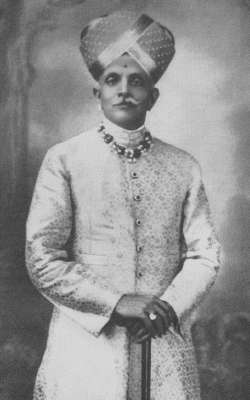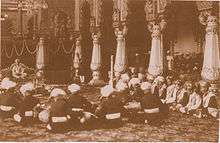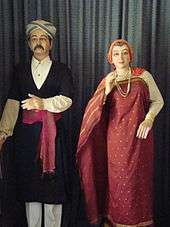Mysore Peta

Mysore Peta (Peta is a Kannada word which means Turban in English) is the classical royal Indian attire worn by the erstwhile Kings of Mysore, called the Wodeyars (1399 to 1947), of the Kingdom of Mysore. Wodeyars wore a richly bejeweled turban made of silk and jari (gold threaded lace) to match with colorful dresses as part of the royal dress.[1]
Administrators under the King, such as the Dewans' (Prime Minister appointed by the King) and other senior officials who swayed considerable power in matters of state administration also doffed the Mysore Peta.[1]
After India became independent in 1947 and the princely state merged with the Indian union, the traditional Mysore peta has been retained as a symbol of heritage and cultural antecedents and distinguished people are honoured by the award of a Mysore Peta with a shawl in formal functions.[1]
Ancient tradition


Kings wore the traditional Mysore Peta as headgear during the Durbar (court of Indian or princley state's kings) time or in a ceremonial procession during the Dassara celebrations and or during joint ceremonial parades with the visiting royal dignitaries from foreign countries.[1]
It was expected that the men attending King's court wore the conventional attire called the durbar dress which comprised a black long coat with white trousers and a compulsory Mysore Peta (turban).[2]
Design
The attractive and colorful turban is a headdress made up of long scarf–like single piece of cloth made of silk or cotton wound round the head cap and is often decorated with jari border (golden or silver laces) and beautiful metal pendants that adds to its glory and grandeur.
In the early 1930s, the "Imperial Hatworks" located in heritage buildings called the Hatworks Boulevard (150 years old history), at No. 32, Cunningham Road, Bangalore, used to make the "pretied Mysore peta" for the Maharajah of Mysore. This place was owned by Manackjee who had set up shop after studying hatmaking in the UK. But this shop closed down a few years after Manackjee's death in 1959. The old–world ambiance of the Hatworks Boulevard has been restored as a minor tourist place with a boutique, French spa, cafe–and–pastry shop, an art gallery (through a tie–up with Crimson Art Gallery), a home furnishing store, an art costume jewellery store and a shop selling custom–made marble pieces.[3]
Social and religious tradition

The people of the Mysore district and the Kodagu district feel proud to wear turbans called Mysore peta. In Kodagu district, it is part of the traditional dress worn on special occasions such as marriages. The Kodagu Peta is slightly different from the Mysore Peta. It is flat on top while the Mysore Peta slopes down on both sides. The Konkani Peta resembles the Kodagu Peta. Men wear a turban during religious ceremonies to portray respect and reverence towards the Supreme Being.Distinguished people are honoured by the award of a Mysore Peta in formal functions.[4]
Even to this day bridegrooms in Southern Karnataka wear the Mysore Peta during the rituals associated with the marriage. It is a traditional sign of respect for the Gujarati people. The turban is known as "PHETA" or "PAGHADI". This shows the responsibility and honor of responsibility.
University Convocation cap
Convocation caps are adorned by students and faculty during convocation ceremonies. This practice has been changed by the Inter–University Board (IUB) of Karnataka, which has ruled that students passing out of the nine universities in Karnataka shall no longer wear the traditional black cap – the mortarboard (as it was considered a British legacy) - during their proud moments. Instead, universities have been given the option of using the traditional Mysore Peta.
The academic cap or square, commonly known as the "mortarboard", a symbol of the academia is a flat square hat with a tassel suspended from a button in the top centre of the board. The tassel is made of a cluster of silk threads, which are fastened by a button at one end and fixed at the centre of the headpiece. In Karnataka University Convocation, students have now the option to wear the Karnataka's traditional Mysore peta, a turban made of silk or cotton cloth with jari tied to the head in a traditional way (tied Mysore petas or turbans are readily marketed for the purpose in most major cities of the state).[5]
See also
References
- 1 2 3 4 Mysore Peta/Turban
- ↑ Turban
- ↑ Adapting to preserve beauty
- ↑ Cultural India: Indian Clothing: Turban
- ↑ http://timesofindia.indiatimes.com/articleshow/1670080.cms Mysore peta in, graduation cap out